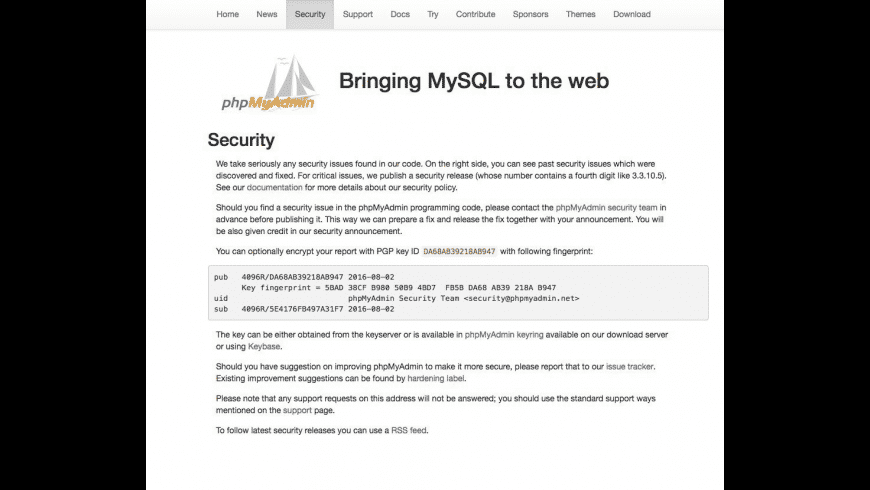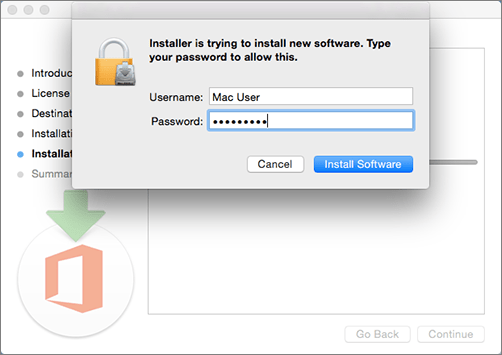- Install Phpmyadmin Mac Mojave
- Installing Phpmyadmin For Mac High Sierra
- Install Phpmyadmin Mac High Sierra
- Install Phpmyadmin Mac Brew
- Installing Phpmyadmin For Mac Installer
Using the Setup script¶. Instead of manually editing config.inc.php, you can use phpMyAdmin’s setup feature.The file can be generated using the setup and you can download it for upload to the server. Next, open your browser and visit the location where you installed phpMyAdmin, with the /setup suffix. The changes are not saved to the server, you need to use the Download button to save them. How to Install XAMPP on MacOS. Introduction XAMPP is a free and open-source, cross-platform web server solution stack which is developed by Apache Friends. XAMPP supports most of the operating systems including Windows, MacOS and Ubuntu. It stands for Cross-Platform(X), Apache, MySQL, MariaDB, PHP and Perl which are also the main components of the stack package. How do I install XAMPP for Mac OS X? To install XAMPP, follow these steps: Open the DMG-Image. Double-click the image to start the installation process. XAMPP is now installed below the /Applications/XAMPP directory. Does XAMPP include MySQL or MariaDB? Since XAMPP 5.5.30 and 5.6.14, XAMPP ships MariaDB instead of MySQL. I recommend manually installing the individual applications to maximize your learning experience. How to Install PhpMyAdmin on Mac OS X. To install PhpMyAdmin, download the latest version. Unzip the file and rename the folder to ‘phpmyadmin.’ Move the ‘phpmyadmin’ folder to ‘/usr/local/phpmyadmin.’. I'm trying to follow this tutorial on how to get started with Python Django but I'm 25 minutes in and all of a sudden the guy pulls up localhost/phpmyadmin and I have no idea how I get that or anything about it on my Mac and I'm just completely lost someone please help thanks.
Introduction
PhpMyAdmin is a free and open source tool for the administration of MySQL and MariaDB. As a portable web application written in PHP, it has become one of the most popular administration tool for MySQL.
In this tutorial, we will learn the steps involved in the installation of phpMyAdmin on MacOS.
Prerequisites

- MacOS
- Login as an administrator on terminal.
- Homebrew must be installed on the system.
- PHP 5.x or greater
Installation
Installation of phpMyAdmin includes following steps
1) Download the file
To install the file on MacOS, we need to download a compressed file from the official website of phpMyAdmin https://files.phpmyadmin.net/phpMyAdmin/4.7.6/phpMyAdmin-4.7.6-all-languages.tar.gz
2) Extract the file
3) Start the development server
To access phpMyAdmin from localhost, we need to start the development server. First, we need to change our working directory by typing the following command:

Development server will be started having the root server in the phpmyadmin directory. Now, type localhost:8080 to access phpmyadmin on localhost. It will appear like this.
Window will prompt us to fill our MySQL username and password. Fill the required details and press GO.
Now we have successfully installed phpMyAdmin on MacOS.

In most of the cases, the MySQL server and phpMyAdmin both are installed on the same server so that the management of the database become easy. However, do you know? We can even access the remote server in the phpMyAdmin with just a little tweak. If not, then here is the tutorial on that.
phpMyAdmin is a PHP based application to easily create, manage, edit, delete, import, and export MySQL databases. That’s is the reason why most of the hosting companies are providing it as a default application either via cPanel or as manually installed on a cloud server. But what about the cloud hosting services especially Cloud hosting such as Google, Amazon AWS Ec2 or LightSail, Digital Ocean, etc. where you manually create a server and separate database instances. Well, yes if we are using some pre-built stack such as Bitnami on them it will install the phpMyAdmin by default, or in case you are installing a database with-in the server instance then you can install phpMyAdmin as well. Both the setup will allow us to access the database application resides on the same server.
However, a separate database instance on cloud is something different. It doesn’t provide root access to the database server in most of the cases to make sure the security of it
In such scenarios, if you still want to manage the cloud or any other web hosting MySQL database then simply install phpMyAdmin locally on your system. Yes, make sure the system you are going to use is secure without any malware. I recommend you should use Linux OS and those are on Windows 10 they can go for WSL (Windows system for Linux) because phpMyAdmin is natively a Linux tool.
Contents
- Access Remote MySQL database on phpMyAdmin
Access Remote MySQL database on phpMyAdmin
Note: if you already have phpMyAdmin installed on your local system or on Webhosting with root access to the server then simply jump to step 4 of this tutorial.
Pre-requisites:
- Internet connection
- A non-root user with
sudoaccess. - Remote MySQL database server address or endpoint.
Step 1: Enable WSL on Window 10 ( Linux user skip this)
Those are using Windows 10 system they can install phpMyAdmin on its built-in Linux system safely with just a single command. In case you already have installed WSL 1 or WSL 2 on your system then move to the next step otherwise see this tutorial first on installing WSL.

Step 2: Install MySQL
As phpMyAdmin itself needs a database to work, thus we a one for it on the local machine or server where you are planning to use phpMyAdmin. Hence, use the below command:
For Debian, Ubuntu or similar Linux uses an APT package manager
Install Phpmyadmin Mac Mojave
For CentOS or RedHat systems
or
Step 3: Install phpMyAdmin locally or on a remote server
Next, step is to set up this PHP based open-source MySQL database management application. Again its installation is not a cumbersome job.
For Ubuntu servers:
For CentOS
First and EPEL repository and then run yum install phpmyadmin.
Step 4: Edit configuration file
Now, before logging in to phpMyAdmin, we need to perform some changes. So, simply on your server command line terminal type below command to edit the configuration file of this DB management system.
⇒User arrow key and scroll down to the end of the file.
⇒Press INSERT key on the keyboard and add the following lines:
After that:
Host: Inside the two single columns given in front of the host value enter the address of the remote database. For example, in the below-given image, we used the address of a MySQL database created on Amazon Cloud. In the same way, you just need to provide the address, it could be IP address as well.
Port: The default ports is 3306. If you have changed it then use that instead.
Next, for security reasons leave the username and password of the Mysql database blank and enter the same while logging phpMyadmin. However, if you know that nobody else is going to access your computer and it is secure. Then simply, add the credential of the MySQL database, user= you-mysql-username, and password= your-myslqdatabase-password.
Installing Phpmyadmin For Mac High Sierra
Now, save and exit the file. For that press Esc button, type :wq and then hit the Enter key.
Install Phpmyadmin Mac High Sierra
Step 5: Run phpMyAdmin to access a remote database
Install Phpmyadmin Mac Brew
Whether you have installed it on the local or some remote cloud/hosting server, after installing the phpMyAdmin; open the browser and type the server’s ip-address/phpmyadmin.
Note: replace the IP-address text with real IP of yours.
Once the interface of this open-source database management tool appears you will see the login screen. Enter the username and password of the remote server, in case you haven’t added in the phpMyAdmin configuration file above. And then click on the Server Choice drop-down box to select the remote server IP address or endpoint link.
Installing Phpmyadmin For Mac Installer

Finally, click on the Go button and this will enable you to access the MySQL database on your locally installed phpMyAdmin.